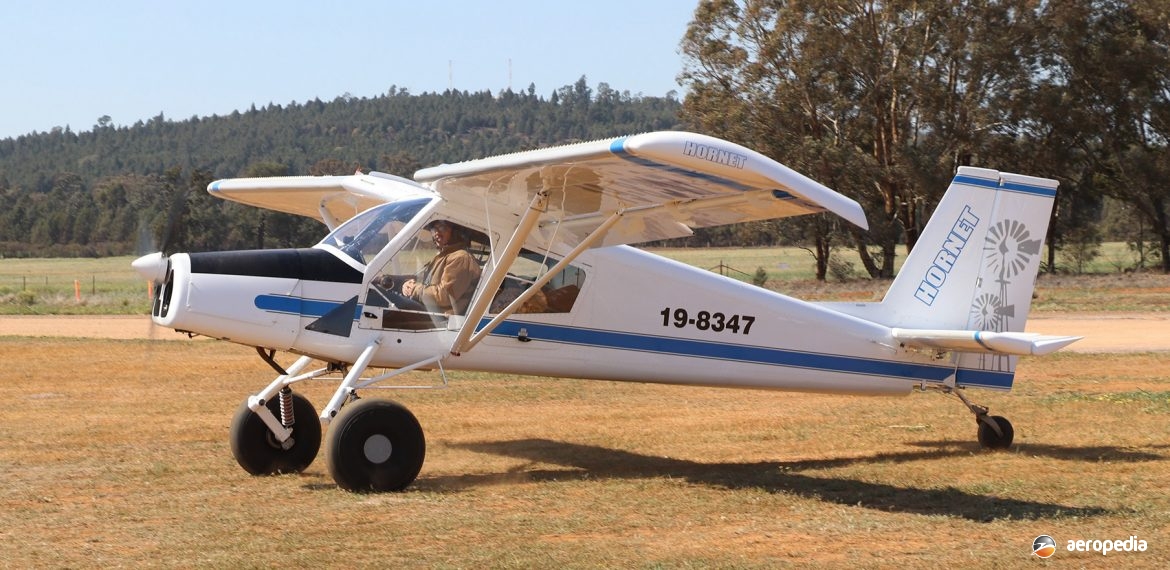Photograph:
AAK Hornet 19-8347 at Parkes, NSW in September 2019 (David C Eyre)
Country of origin:
Australia
Description:
Two-seat high-wing light sport aircraft
Power Plant:
One 75 kw (100 hp) Hirth 3701ES three-cylinder, two-stroke, engine
Specifications:
- Wingspan: 8.8 m (28 ft 9 in)
- Length: 6.4 m (21 ft)
- Height: 2.4 m (7 ft 9 in)
- Max speed: 185 km/h (115 mph)
- Cruising speed: 148 km/h (92 mph)
- Take-off speed no flaps: 74 km/h (46 mph)
- Landing speed: 102 km/h (63 mph)
- Stalling speed: 59 km/h (37 mph)
- Rate of climb at 480 kg: (1,058 lb) 488 m/min (1,600 ft/min)
- Empty weight: 310 kg (683 lb)
- Loaded weight: 600 kg (1,323 lb)
History:
The Hornet was designed by Ole Hartmann of Australian Aircraft Kits as a large, roomy, short-take-off and landing, light sport aircraft suitable for manufacture by the amateur builder. With a large luggage space, and good cross-country performance, it became available in 2004 in kit form and has been manufactured in the Company’s facility at Laurieton on the mid north-coast of New South Wales. The kit provided long-range tanks, aluminium undercarriage to suit, plastic wingtips, fairings and cowling, wheels with bush tyres and many other parts.
The Company was also the local distributor for the chosen power plant, the 45 kw (60 hp) HKS700E four-stroke unit, although other units ranging in power from 45 kw (60 hp) to 90 kw (120 hp) have been installed, including Jabiru 3300, Hirth 3701 ES, Rotax 912S, Rotax 914, ATP2000 turbine, KP36, and Subaru EA81, usually driving a three-blade ground-adjustable propeller. In 2005 it was announced the 82 kw (110 hp) Rotec radial engine would be available for installation as an option. A few have been installed in production aircraft. Examples have also been fitted with the Lycoming O-320.
The Hornet was initially available in two forms, the Hornet STOL and the Hornet AG utility. It has been advertised as a two-seater but has space for two persons plus cargo, or two-plus-two, ie room for two children. In the Experimental GA Category the area behind the seats may take luggage, freight, or two small seats. The undercarriage was designed for unprepared airstrips and operation from rough terrain. Construction was semi-monocoque all metal and was corrosion resistant. It could be fitted with a tailwheel or tricycle undercarriage and disc brakes. Standard fuel was 80 litres (17.6 Imp gal).
The prototype 19-4077 was completed in early 2004 and was demonstrated at the NATFLY 2004 event at Narromine, NSW when it was awarded the Australian Ultralight Federation award for the “Most Innovative Ultralight Design”. First commercially sold kit (c/n S001) fitted with a 75 kw (100 hp) Rotax engine was built at Katoomba, NSW, being completed in 2006, and was followed by VH-KNL (c/n AG001P), completed at Barrington Tops, NSW. The first Hornet STOL (c/n S003) became 19-4251 and became a demonstrator, in late 2005 being fitted with the Australian designed and built 75 kw (100 hp) Rotec seven-cylinder radial engine.
The next Hornet STOL (c/n S004) was built in Darwin, NT and, after completion, entered service in north Queensland. Further kits have been sold and have been completed at Tamworth and Narrabri in NSW, in Western Australia, and in Tasmania. Production continued, c/n S009 becoming VH-CVH in November 2006 at Mt Isa, QLD. By early 2009 23 Hornets had been delivered, one being fitted with a Lycoming O-320 engine.
AAK has continued to develop aircraft types, a new variant of the Hornet emerging in late 2006, this being known as the Super Hornet, seating six-seven, which has been designed for mission requirements in third world countries and in areas where STOL performance and good load carrying capacity is required, such as Africa and New Guinea. A further design was known as the Sonic, a high-performance research aircraft seating two, which was to be completed late in 2006.
Further variants have been built, one being the Hornet TUG, a special variant the first of which became VH-OHT with the Bacchus Marsh Gliding Club in Victoria, this aircraft being used to tow local gliders. It was powered by a converted 2.3 litre Subaru liquid-cooled engine providing 119 kw (160 hp) driving a Warp Drive four-blade ground-adjustable propeller.
In early 2022, after 62 Hornets had been delivered, the company announced a new variant of the Hornet known as the Cub Classic, powered by a Rotax 914 engine fitted with dual controls. It used the Hornet STOL wing, and the maximum take-off weight was 700 kgs.

